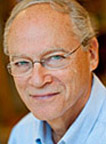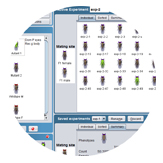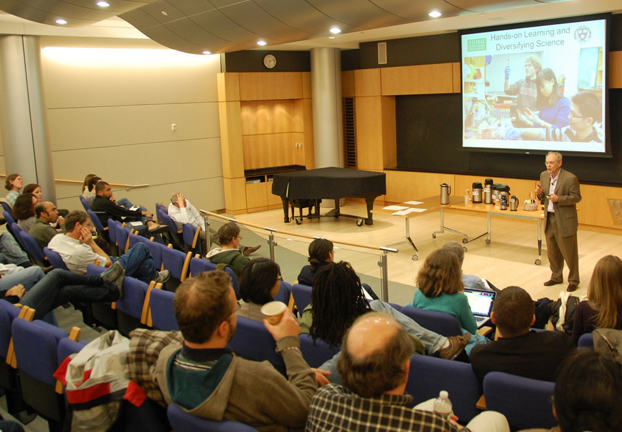Back to Seminar Archive List
 HHMI Professor Rich Losick
HHMI Professor Rich Losick
Seminar Topic: Hands-on Learning and Diversifying Science
Seminar Date & Time: Friday, April 15, 2011 @ 2:00 pm
Location: Whitehead Institute Auditorium
Hosted by: The Education Group
View the slides from Professor Losick’s Seminar at MIT on April 15, 2011.
Both for his scientific research contributions and his sincere dedication to students, Professor Rich Losick is truly an inspiration to all who meet him. He generously communicates his thoughts and ideas about scientific research and science education with touching modesty, genuine compassion for others, and a sparkling sense of humor.
In his research laboratory within the Department of Molecular and Cellular Biology at Harvard University, Professor Losick works with students and postdoctoral fellows to investigate bacterial cell division, sporulation, and biofilms, generating findings that inform the development of antimicrobial agents, the engineering of clean water supplies, and other applications. Outside of his laboratory, Professor Losick also displays a profound dedication to mentoring young scientists, both through the courses that he develops and teaches at Harvard University and in his HHMI-funded work to help promising undergraduate students from disadvantaged backgrounds succeed in science and math-related fields of study.
Professor Losick began his talk at MIT on April 15, 2011 by discussing the importance of good mentoring in supporting the development of young scientists. He spoke of the positive impacts on his own academic life that derived from helpful mentoring received from his own undergraduate advisor, Professor Charles Gilvarg of Princeton University. Sharing images of thoughtful handwritten comments that Professor Gilvarg had recorded on a young Rich Losick’s 1965 undergraduate thesis, Professor Losick remarked on how significant such feedback from mentors can be in encouraging student success. Losick went on to speak about how he had benefited from further mentoring by Professors Phil Robbins, Boris Magasanik, and Salva Luria during his graduate studies at MIT. Luria, Professor Losick recalled, would invite students to his home for discussions about existentialism because he found the standard biology curriculum to be too narrow.
Inspired by his own mentors, Losick has taken action to support mentoring relationships between students and faculty across the Harvard campus. In 2002, with the help of his first HHMI Professor Grant, Professor Losick developed two programs to bring students and faculty together in long-term mentoring relationships: the “Increasing Diversity and Education Access to Sciences” (IDEAS, formerly called FEEDS) program and the “Life Sciences 100″ program. Partnered with Dr. Tom Torello (Concentration Advisor in Biochemical Sciences, Harvard University) and Dr. Rob Lue (Director of Life Sciences Education, Harvard University), Losick scours the entering freshman class each year searching for students who (i) have a passion for science or math and (ii) are at high risk for not completing a course of undergraduate study in these fields because they come from disadvantaged backgrounds.
Losick explained that the students selected for the IDEAS program come to Harvard already excited about science, and his goal is to help make sure that they are still excited about science when they leave Harvard. “My only mission is not to mess it up,” he humbly told the audience at MIT.
Once identified by the IDEAS program through their personal essays and through interviews with Losick and colleagues, each student is carefully matched with a faculty research mentor and placed in a laboratory by the Spring of his or her freshmen year at Harvard. So that these students don’t need to work part-time jobs that might distract them from their studies, the IDEAS program pays the students for conducting laboratory research work, part-time during the academic year and full-time during the summer term. Professor Losick also helps to foster community among the students in the program, hosting dinners and an annual Spring Retreat at MIT’s Endicott House. Professor Losick and colleagues keep an eye on the IDEAS students throughout their time at Harvard, ensuring that the established mentoring relationships are a good fit. The result? Talented at-risk students are supported during their undergraduate studies while, as a direct consequence, science and math-related fields become increasingly diversified.

Left: Handwritten comments from Princeton Professor Charles Gilvarg on a young Rich Losick's 1965 undergraduate thesis entitled "Effect on growth of E. coli lysine auxotroph and use in derepression of lysine pathway". Right: Professor Losick with a number of IDEAS program students on retreat at Endicott House. Click to view larger images.
Professor Losick was delighted to introduce two successful graduates of the IDEAS program who were in the audience on April 15th: Ying Qi “Shirleen” Soh, now a member of Professor David Page’s research laboratory at the Whitehead Institute for Biomedical Research, and David Sengeh, now working within the Biomechatronics Group in MIT’s Media Lab.
Professor Losick vocally advocates for changing the culture of science education at research universities. Losick believes that there is no better way to teach science than to engage students in doing science. He also remarked on the need for more college-level programs that support cross-disciplinary learning. He told the audience at MIT about Harvard’s multi-disciplinary undergraduate teaching labs, located in the new Northwest Science Building completed in 2008. These teaching labs operate like real research labs and emphasize collaborative learning among undergraduate students approaching research problems from a variety of scientific and engineering perspectives. The lab space includes conference rooms for student use and was constructed with as many glass (rather than opaque) walls as possible to promote collaborative interactions. Professor Losick mentioned a new research project, begun in these teaching labs in 2010 and mentored by Dr. Rachel Dutton and a team of postdocs and graduate students, in which students use cheese as a model system for the study of microbial ecosystems!

A selection of photos from the cheese project - a research activity in which students use cheese as a model system for the study of microbial ecosystems - conducted under the mentorship of Dr. Rachel Dutton in the multi-disciplinary undergraduate teaching labs at Harvard University. Click to view larger images.
Professor Losick encourages faculty and instructors to get creative in their teaching. His sense of humor bubbled to the surface as he shared with the MIT audience two videos of DO-try-this-at-home theatrical “stunts” that he employs in his undergraduate Biology curriculum at Harvard. In one of these “stunts”, Professor Losick uses analogy to a crab claw to illustrate the structure and function of bacterial RNA polymerase. (See the crab claw in action!) In another “stunt”, Losick and colleagues play tRNA molecules delivering amino acids to a ribosome to generate a polypeptide through the process of translation. (Watch Professor Losick play the role of a tRNA!) “There is no level to which I won’t stoop to get a rise out of students,” Losick reported, laughing along with the MIT audience.
During his talk, Professor Losick also announced an exciting upcoming event at Harvard University: Princeton University President Shirley M. Tilghman will deliver the next Dudley Herschbach Teacher/Scientist Lecture — named for Harvard Professor Emeritus Dudley R. Herschbach, who came from a non-scholarly background and, with the early support of fine mentors and scholarships, ultimately went on to win the Nobel Prize in Chemistry and to become a strong proponent of science education and science among the general public, frequently giving talks to students of all ages.
Responding to a question from his MIT audience, Professor Losick worried that, too often, university-level academics see teaching and research as pursuits in competition. He remarked that he was disappointed to learn that, at some research universities, those professors who bring in the most research grant dollars can “buy themselves out” of their teaching responsibilities. “What kind of message is it when less able colleagues, research funding-wise, are the ones doing the teaching?” Losick wondered aloud. Professor Losick’s recent essay on this troubling situation appears in the May 2011 online issue of the HHMI Bulletin (Vol. 24, No. 2).
Professor Losick closed his talk on April 15th with words of sage wisdom. “Science and teaching go hand-in-hand. I am a better teacher for being a scientist. But I am also a better scientist for being a teacher.”
Professor Rich Losick is a member of the HHMI Society of Professors and a Maria Moors Cabot Professor of Biology in the Department of Molecular and Cellular Biology at Harvard University. For more information about Professor Losick’s science education-related work, please visit his Society of HHMI Professors Web Bio.




